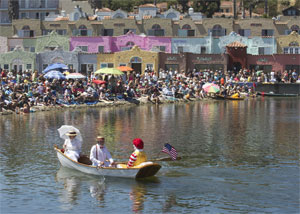How We Got Here
By Carolyn Swift – Director, Capitola Historical Museum
As autumn approaches the California coast, summer fog begins to drift offshore. Skies are clear, days warm, and evenings balmy.
This is the Golden State at its best. Nowhere is a late summer sky brighter and in a more festive mood than in Capitola, a city with so much “flower power” that it was once known as the Begonia Capital of the World.
The flower industry took root shortly after 1900, when a diversity of bulbs and flowers had been introduced here. The vibrant Begonia, however, was easily the most celebrated. Primary grower James Brown was by 1919 a renowned producer, supplying flower seed as well as Begonias, Freesias and Gloxinias, which he imported from Europe. Brown traveled through Europe in 1920, returning with a honed expertise that helped him double his production.
Shortly after World War II, Capitola-Santa Cruz Airport managers Esther and Russell Rice began promoting Capitola as the Waikiki of the West. Esther, a longtime friend and classmate of the Browns, went to their fields and chose giant blossoms to give away to visiting aviators. Decades afterward, she kept a stack of letters and photographs sent by the pilots once they returned home and showed off their impressive prize to family and friends.
In 1949, the new city boundaries of Capitola embraced the fields of nearby nurseries spreading. When a symbol was needed for an annual celebration, the choice was easy. Vetterle and Reinelt hybridizing gardens, Antonelli’s Begonia Gardens and the enduring Brown Bulb Ranch all had award-winning lath and green houses within walking distance of the beach.
In 1950, a professional swimmer, Peggy Slatter Matthews, who had performed in the late Thirties with the Billy Rose Aquacade in San Francisco, came to Capitola and soon organized its first autumn water carnival. She chose Begonias to decorate the barges used by swimmers in her Capitola Water Fantasy production.
Considered the start of our modern festival, the 1952 water fantasy show introduced live music to complement the swimmers as they performed water ballets. Twelve Begonia-trimmed floats were judged in a water parade, followed by a “fantasy dance” at the Capitola Ballroom.
Capitola Begonia Festival was organized with an official title two years later in 1954. Over coffee, Helen Antonelli and Vivian Benias designed a pageant to showcase the Begonia blossom by itself. In that 1954 festival six floats used 35,000 blossoms picked local fields.
As the summer of 2013 draws to a close, another weekend will add to 61 years of memories.
Capitola Magic! Sixty-One Years of The Begonia Festival

